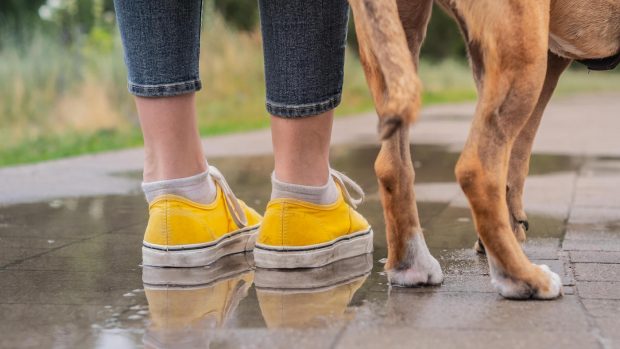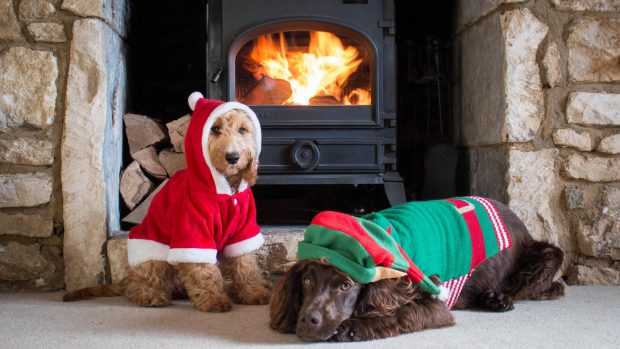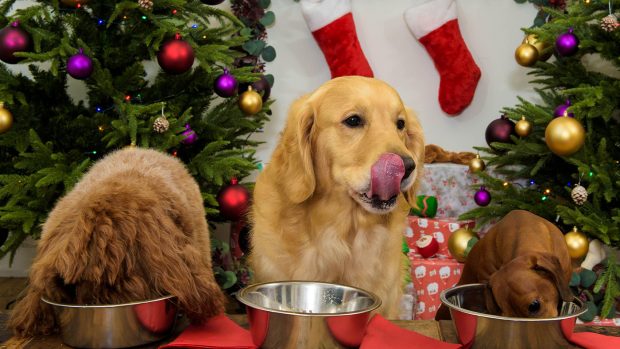Studies have shown that up to 65% of dogs in the UK are obese, so if you’re wondering how to help a dog lose weight, then you’re certainly not alone. The first step in dealing with an overweight dog is to recognise and acknowledge there’s a problem – so you’re already on the right track.
Obesity in dogs is not just about overfeeding – there are other factors that can have a pivotal effect on your dogs’ weight, such as diabetes, underactive thyroid and neutering (as this removed hormones that can help to balance weight). Cushing’s disease can be hard to diagnose as it’s often mistaken for the natural ageing process. Reduced mobility due to osteoarthritis or hip dysplasia will also play a part in weight gain.
Is my dog overweight?
It can be challenging to understand what normal looks like as there are so many overweight dogs around, but there are a few signs you can look out for.
- breathlessness
- reduced mobility
- panting excessively
- refusing to move or play and lagging behind on walks – assuming pain is ruled out
- a rounder face
- abdominal sagging
You can ask your vet to assess your dog’s body condition during a routine visit. In between visits, you can check his rib coverage at home. Feel your dog’s ribs just behind his shoulder blades – they should feel similar to your knuckles when your hand is placed palm down in front of you. If it feels fleshier, then chances are there’s weight to be lost – but it’s important to bear in mind that dogs of different breeds will vary.
How to help a dog lose weight
The general rule for weight loss – dog, horse or human – is feed less, move more. But there are a few things you can implement to help you achieve this.
1. Increase the exercise – assuming there are no health problems, physical impairments or injuries. This could be a longer walk, an additional walk or more high-energy playtime.
2. Cut down food – and take high-value rewards and treats out of the daily allowance if you’re training. Do not feed titbits or leftover human food. If you need to give your dog something to chew or enrichment during periods you are out, use part of their feed from their daily allowance and put it in a toy, such as a Kong Classic (which you can get on Amazon), one of the best puzzle toys, or an old bone with no marrow in it or meat on it.
3. Choose good food – make sure that the food you are feeding your dog does not have a high fat content. Generally, the less processed the better – opt for steamed meat, such as Nature Diet or Forthglade (both of which you can find on Amazon). If you really must feed dry dog food, look at the fat content and perhaps feed a cold-pressed kibble of white fish.
4. Split meals into smaller ones across the day so they are eating less but more often. I feed my tribe like kings and queens in the morning, but paupers in an evening. They need their energy in the daytime and have time to burn it off, whereas if you are feeding them large quantities at night it will just turn to fat as they rest.
5. Create a feeding plan and keep a food diary together with fortnightly weigh-ins. This way you can monitor your success or visit your vet if nothing has changed. They can then run other tests to see if there is any underlying medical issue, such as diabetes or an underactive thyroid gland.
Some vets will prescribe weight loss food. These tend to have a lot of filler and will swell in the stomach, so the dog feels full. I have noticed dogs on this food will tend to become quite miserable as they are “fake full” and lacking nutrients to maintain balanced cognitive function.
Weight charts have their uses but can be a bit out of date and it’s better to check whether you can feel a waistline and the outline of ribs. Personally, I do not like to feel a prominent spine or hips bones – but, of course, you will get a very different feeling if you were assessing a correct weight mastiff to a whippet.
How to increase exercise in an obese dog
Exercise must be done gradually as the dog starts to lose excess weight. If you have a morbidly obese dog, its not fair to take them out for a two hour walk straight off the bat – and it is likely to do more harm than good. Begin by increasing walks by five minutes per day. If your dog is toy- or ball-motivated add some time in the garden initially (around 5–10 minutes) playing catch or retrieve.
As the weight loss starts to become apparent, you can then add throwing a ball or toy into the daily walks. Consider taking up agility or flyball. Build up their fitness gradually and, once the dog begins losing weight, you can use your knowledge of your dog’s health and mobility to increase the output in walks and other training exercises.
Swimming is good for dogs with arthritic joints as well as weight loss programmes. Hydrotherapy is not just for a recovering patient or an elderly stiffer dog, it can also be used successfully to aid weight loss as it takes all the pressure of the joints while expelling energy and calories.
Keep in close contact with your vet during a weight loss regime to rule out injuries and any underlying factors should the dog still be gaining weight or not losing weight.
Health problems caused by obesity
Research has shown that fat isn’t just a lifeless energy store that slows your dog down, but it secretes hormones that effect appetite, inflammation, water balance, blood pressure, insulin sensitivity and bodily function. Some of the conditions listed below are symptomatic of obese dogs:
- Diabetes
- Cancer
- Heart disease
- Hypertension
- Osteoarthritis and faster degeneration of affected joints
- Increased risk of injury to patella and cruciate ligaments
- Back injuries
- Urinary bladder stones
- Anaesthesia complications
- Kidney disease
- Liver disease
You might also be interested in:

Struggling with a scrawny pup? Here’s how help your dog gain weight

Gently does it: best slow-feeder dog bowls for speedy eaters

Can dogs eat ice cream?

Naturally delicious: the best raw food meals to help your dog flourish

Simply delicious: the best natural dog treats

Subscribe to Horse & Hound magazine today – and enjoy unlimited website access all year round
Horse & Hound magazine, out every Thursday, is packed with all the latest news and reports, as well as interviews, specials, nostalgia, vet and training advice. Find how you can enjoy the magazine delivered to your door every week, plus options to upgrade your subscription to access our online service that brings you breaking news and reports as well as other benefits.




